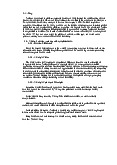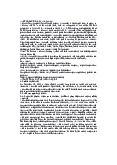






Preview text:
Tugas 1 Kelompok 9 Nama anggota :
1. Jack Daniel Jeffrosson Purba (22/503628/EK/24114)
2. Ghina Shabrina (22/498411/EK/24031)
3. Jacques Ethan Nathanael Gultom (22/493143/EK/23804)
4. Hilda Bhakti Fahrezi (22/497256/EK/23952)
5. Sherly Cindy Carolina (22/506083/EK/24185)
1. From the starbucks case, answer the followings:
1. In what ways do you think Starbucks increases its brand recognition with its EC initiatives?
2. Some criticize My Starbucks Idea as an ineffective “show off.” Find
information about the pros and cons of the program. (See the Starbucks Ideas in Action Blog).
3. Starbucks initiates discussions on Facebook about nonbusiness topics
such as the marriage equality bill. Why?
4. Discuss how customers are being kept involved and engaged in the various EC initiatives.
5. Starbucks believes that its digital and social initiatives are “highly
innovative and cause dramatic changes in consumer behavior.” Discuss. 2. Watch the video E-Commerce Part 1 (10:03 min) at
youtube.com/watch?v=gOVh-r03zxQ.
1. Update all the data shown in the video.
2. What fundamental change is introduced by EC?
3. What is the first mover advantage discussed in the video?
4. Amazon.com and other companies that lost money during the time the
video was made are making a lot of money today; find out why.
5. Identify all the EC business models discussed in the video.
6. How can one conduct an EC business from home?
7. EC is considered a disruptor. In what ways?
3. Research the status of self-driven cars. Outline the pro and con points. Why this is considered EC?
1. From the starbucks case, answer the followings:
1. Starbucks deployed several e-commerce projects, such as: a. Online Store
Starbucks sells many of their products online at store.starbucks.com. These
offerings include coffee, tea, and Starbucks equipment and merchandise. The
company completely redesigned the webstore to make shopping more
convenient and easy. In addition, customers can schedule deliveries of standard and special items. b. The eGift Card Program
Customers can buy Starbucks customized gift cards digitally. Payments can be
made with a credit card, through PayPal, or the Starbucks app for mobile
devices and the gift card is sent to the recipient via e-mail or postal mail. c. Loyalty Program
The company offers a loyalty program (My Starbucks Rewards). Those who
reach the gold level receive extra benefits. d. Mobile Payments
Customers can pay at Starbucks stores with prepaid cards. Payment is made by
selecting “touch to pay” and holding up the barcode on the device screen to a scanner at the register. e. Social Media Projects
Brand recognition defines how consumers of that brand can identify a
particular brand from its attributes. Starbucks is active in the world of social
media such as Facebook, LinkedIn, Twitter and Instagram. They call this
method "Social Media Projects". By being active on social media, Starbucks is
able to improve relationships with consumers, because Starbucks becomes
more aware of the wants, needs, preferences that consumers mean. With the
increasing existence of Starbucks on social media, Starbucks is increasingly well known.
2. Pro(s) and con(s) of My Starbucks Idea a. Pro(s):
My Starbucks Idea encouraged customers and fans to share their ideas and
suggestions for how to make the company’s beloved products even better. The
founder, Howard Schultz, said that Starbucks needs to put themselves in the
shoes of their customers. This idea worked well and proved over the first five
years of operation, the platforms received over 150.000 ideas and the company
put hundreds of them to use. Starbucks demonstrates the value of open
innovation. By handing power over to customers and by giving them an
incentive to participate by recognizing their ideas, Starbucks was able to
channel a lot of crowd creativity. b. Con(s):
My Starbucks Idea handing the keyboard over to the customer can open a
company up for online criticism and even harassment. Open innovation
sometimes can ve something of a double-edged sword. This idea opens any
trolling or abuse and the opportunity for platform from becoming a tool for corporate mockery.
3. Why Starbucks initiates discussions on Facebook about nonbusiness topics such as the marriage equality bill?
As we know before, Starbucks maintains a very strong media presence on
Facebook. They gained over 36 million likes for uploading videos, blog posts,
photos, promotions, product highlights, and special deals. Starbucks kind of
takes advantage of their strengths not solely for money but rather to embrace
diversity. A little background from Starbucks, this company has supported
same sex marriage and they have tried to make the place as comfortable as
possible for the LGBTQ. A strong enough reason why Starbucks wants to
make the LGBT community feel comfortable is probably because Starbucks
wants to gain a sense of trust and also they want to be seen as a company who
offers best products, best services, and also knows their customers well.
4. How customers are being kept involved and engaged in the various EC initiatives
● Consumers and employees can make suggestions for improvement, vote for
suggestions, ask questions, collaborate on projects, and express their complaints and frustrations.
● Starbucks provides diversified, business data about the company, employee
profile, and available jobs information and easy to access
● Starbucks gives incentives for does who contribute ● Interactive marketing
5. Starbucks believes that its digital and social initiatives are “highly innovative and
cause dramatic changes in consumer behavior.
Starbucks is less innovative, because most of their ideas have been widely
used by other brands. However, Starbucks managed to change the perspective
of society. For example in Indonesia, Starbucks is like a standard and that part
is the most innovative idea. By taking advantage of people who think that
going to Starbucks is included in the "upper class" they will "show off" if they
are at Starbucks which will further raise the Starbucks brand name. So,
Starbucks managed to change people's behavior with its brand. 2. Watch the video E-Commerce Part 1 (10:03 min) at
youtube.com/watch?v=gOVh-r03zxQ.
a. Update all the data in the video!
The video itself is explaining about the EC framework, the strategy process, the media
convergence, the internet itself, the EC characteristics, and the category. The
framework itself is composed by six parts such as, framing the market opportunity,
defining the business model, customer interface, market communication and branding,
implementation, and evaluation. The strategy process is rests on two key platforms,
first is the network infrastructure and second is the convergence of alternative forms
of media. The convergence itself happened between the traditional media
infrastructure (such as tv, radio, etc) and the internet.
b. What fundamental change is introduced in EC?
The fundamental change introduced by EC (Electronic Commerce) is the shift from
traditional physical transactions to digital transactions facilitated through the internet and other electronic networks.
c. What is the first mover advantage discussed in the video? Setting industry standards,
the first-mover in EC can set the standards for the
industry, which can influence the way that future competitors operate.
d. amazon.com and other companies that lost money during the time the video was made
are making a lot of money today and find out why?
Because Amazon and the other company are making a lot of money today because the
growth of EC, the growth of e-commerce has been a significant driver of revenue for
companies like Amazon. As more consumers have turned to online shopping,
Amazon has been well-positioned to capture this trend.
e. Identifies all the EC business models discussed in the video!
There are B to B (Business to Business), B to C (Business to Customer), C to B
(Customer to Business), C to C (Customer to Customer). f.
How can one conduct an EC business from home?
By using online store platform such as amazon, tokopedia, etc
g. EC is considered a disruptor. In what ways?
Retail and traditional businesses were disrupted by e-commerce in a way that was
bizarre but inevitable. This online shopping trend created an inevitable shift in selling
strategy for retailers. Be it giant retail organization with global footprints, or young
start-ups aiming big; everyone wanted to set an online avenue to engage customers.
This was quite obvious, because of numerous motivations to sell online such as
increased market reach, augmented revenue opportunity, expanded product diversity,
competitive advantage, all-round seamless omni-channel experience, etc. And now,
E-Commerce has multiplied and evolved into a bigger monster.
3. The status of self-driven cars:
There has been incremental, but steady, progress in the development of self-driving cars.
Some form of driver-assistance technology focused on safety is now inside most new vehicles.
The Society of Automotive Engineers (SAE) defines six levels of vehicle driving automation
systems. Right now, we're at level two, with cars able to control steering, acceleration and
braking, while still requiring drivers to remain engaged. Down the road, level 5 autonomy
would mean fully driverless cars.
Pros of self-driven cars:
● Machines don’t get tired.
Many accidents are caused each year due to the fact that drivers fall asleep while
driving their cars. By using self-driven cars, drivers could actually fall asleep without
causing any trouble since the machine would navigate through the traffic and the
number of accidents could be greatly reduced.
● Robots make fewer mistakes.
We as humans have so many different things running through our minds that we are
not always able to fully concentrate on driving. This often leads to mistakes and
accidents. Through the use of self-driving cars, those accidents could be prevented..
● Systems do not have emotions.
People might become angry due to a driving maneuver of another driver and might
seek revenge for that. In contrast, self-driving machines would not become angry at
all and would stay rational and safe instead, which could potentially save many lives
that would otherwise be lost through traffic accidents. ● No risk of drunk driving.
Many accidents on our roads also happen since people are driving drunk or under the
influence of drugs. Through the use of self-driving cars, this issue can be mitigated
since the car will carry out all tasks and navigate through traffic.
● Self-driving cars follow traffic rules.
Self-driving cars will also follow traffic rules. They would strictly comply with the
speed limits and would do everything that traffic safety is ensured.
● Improvements in mobility for people who can’t drive. Especially for people who can’t
actually drive due to health issues or other problems, self-driving cars could be a great alternative.
● More convenient driving experience.
By using a self-driving car, you could simply sit back and relax since your car will be
able to navigate through the traffic. You could even read a book or do something else
you like to do instead of focusing on the traffic. It also can makes working while driving possible.
● Potential lower insurance costs.
Insurance companies might also reward you for getting a self-driving car since the
chances for accidents may be lower and therefore, your insurance premium may
become lower as well. Thus, even though self-driving cars may be more expensive
compared to conventional cars, you could save plenty of money on your car insurance in the long run. ● May be faster on average.
Self-driving vehicles process plenty of information every second.
They are able to constantly update the fastest route and may be better able to change
directions once they detect traffic jams or other issues compared to humans.
● Savings on fuel and improving air quality.
Since self-driving cars are much better to anticipate changes in traffic conditions and
therefore could navigate more smoothly, the use of autonomous vehicles may also
lead to a decrease in fuel consumption.
Through a reduction in fuel consumption, also the air quality in big cities could be significantly improved. ● Reduction in car thefts.
Since self-driving cars are usually equipped with quite advanced technology, thieves
may refrain from stealing these cars since they fear to get caught pretty soon. ● Economic advantages.
Since the number of car accidents could be significantly reduced, also government
spending for the police and ambulance could be significantly lowered. In turn, this
would save plenty of taxpayer money.
Cons of self-driven cars: ● Higher unemployment rate.
the use of self-driven cars may lead to higher unemployment in the transportation
sector since many cab drivers are no longer needed anymore.
● People may unlearn how to drive manually.
Many people will no longer be able to drive manually. Once the self-driving system
suffers from any issues, it might be important to be able to navigate the car manually in a safe manner. ● High R&D costs.
Even though the technology behind autonomous vehicles is quite promising, plenty of
money has still to be invested in order to make it safe enough for mass transportation.
● High initial purchase price.
Especially in the beginning, self-driven cars will be quite expensive.
● Maintenance may be difficult and costly.
Many car repair shops may not be able to fix issues of self-driving cars in a proper
manner and owners of those cars may have a hard time finding someone who is
experienced enough in this field to fix his car. ● Privacy concerns.
Since plenty of data is needed in order to make autonomous driving possible, critics
of autonomous cars often have serious privacy concerns regarding this technology.
self-driven car companies have to make sure that personal data is properly protected
and not misused in order to keep the trust of the general public.
● Fun of driving may decrease.
Many people also enjoy driving their cars very much. For them, driving their car is
their hobby and those people might not be happy with a self-driven car. ● Moral concerns.
Self-driving is also often criticized due to ethical concerns. For instance, in case of
emergency, an autonomous car has to decide whether it wants to take action A or B.
Let’s assume action A is hitting another car and action B will result in an injury for
the driver due to a sidestep. If there are no other options, the car has to decide whether
it wants to save the driver or the other car. Many people claim that this cannot be
justified from an ethical standpoint that we let machines decide when it comes to
saving or taking the lives of people. ● Technical errors.
Due to the fact that the technology behind self-driving cars is not mature yet. ● Hacking issues.
If hackers are able to attack the systems that are needed for self-driving cars to work
properly, this could lead to a variety of serious accidents.
● Bad weather may prevent technical systems to work properly.
If there is heavy rain or a snowstorm, it is hard for self-driven cars to navigate
properly since the sensors might not work in a reliable manner. Thus, researchers also
have to solve this issue before autonomous cars can be used by the general public on a large scale.
● High regulatory restrictions.
Car companies might have a hard time convincing regulators regarding the safety of autonomous cars. Daftar Pustaka 2021. How Starbucks Is Changing to A Digital And Social Enterprise.
https://www.studocu.com/row/document/comsats-university-islamabad/international-trade-an
d-business-law/starbucks-case-study/35686004, diakses pada 21 Februari 2023 pukul 19.00. Chakravanshi, Siddharth. 2017. Digital Disruption and E-Commerce.
https://www.linkedin.com/pulse/digital-disruption-e-commerce-siddharth-chakravanshi,
diakses pada 22 Februari 2023 pukul 21.00. Read cash. 2021. Starbucks’ Customers and its EC Initiatives.
https://read.cash/@Eirolfeam2/starbucks-customers-and-its-ec-initiatives-cb676952, diakses
pada 22 Februari 2023 pukul 22.30.




